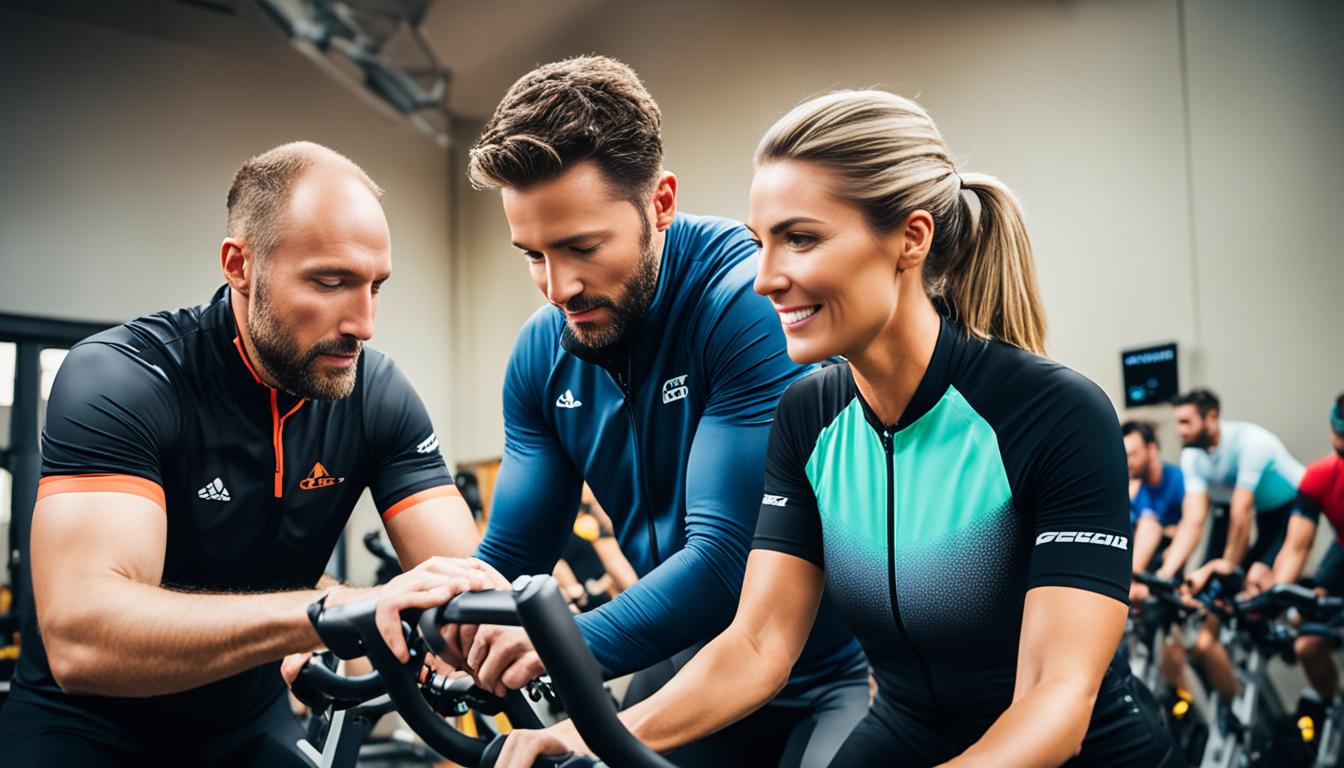Indoor cycling workouts have gained popularity over the years, offering a unique and effective way to improve physical fitness. Whether you choose to join a group class at a gym or cycling studio, cycle solo at home, or transform your own bike with a trainer, indoor cycling provides numerous benefits.
Indoor cycling training allows you to tailor your workouts to your specific goals and preferences. With a variety of indoor cycling classes available, you can choose a class that suits your fitness level and interests. These classes typically offer a structured routine, combining cardiovascular exercises with muscular endurance and strength training. In addition to the physical benefits, indoor cycling classes provide a social and motivational environment, allowing you to connect with like-minded individuals and push your limits.
If you prefer solo workouts, indoor cycling at home or in your own gym can give you the flexibility to exercise on your schedule. You have the freedom to design your own workouts, choose the duration and intensity, and focus on areas that need improvement. This option is ideal for those who enjoy the solitude of exercising and want to personalize their fitness routine.
The benefits of indoor cycling extend beyond physical fitness. These workouts can improve cardiovascular endurance, lower-body muscular endurance and strength, and aid in weight loss. The low-impact nature of indoor cycling makes it suitable for individuals of all fitness levels, including beginners.
Whether you’re a seasoned indoor cyclist or a beginner looking to start, this comprehensive guide will provide you with the information you need to revamp your fitness through indoor cycling workouts.
Key Takeaways:
- Indoor cycling offers a versatile and effective way to improve physical fitness.
- You can choose between group classes or solo workouts based on your preferences and goals.
- Indoor cycling provides both physical and social benefits, allowing you to connect with like-minded individuals.
- It is a low-impact exercise that can improve cardiovascular endurance, lower-body strength, and aid in weight loss.
- Whether you’re a beginner or experienced cyclist, indoor cycling is suitable for all fitness levels.
Solo vs. Group Indoor Cycling Workouts: Pros and Cons
When it comes to indoor cycling workouts, you have two options to choose from: solo rides or group classes. Each option has its own set of advantages and disadvantages that you should consider before making a decision. Let’s take a closer look at the pros and cons of both solo and group indoor cycling workouts.
Solo Indoor Cycling
One of the main benefits of solo indoor cycling is the flexibility it offers. You have the freedom to create your own schedule and customize your workout according to your preferences. Whether you want a high-intensity ride or a leisurely pedal, you can tailor your solo sessions to suit your needs.
Another advantage of solo rides is the ability to focus solely on yourself and your goals. You can concentrate on your form, cadence, and personal performance without any distractions. This can be particularly beneficial if you prefer a more individualized approach to your workouts.
“Solo indoor cycling gives you the freedom to choose your own ride, set your own pace, and focus on your personal goals.”
However, solo indoor cycling also has its drawbacks. Without the guidance of an instructor, it can be challenging to push yourself to new limits or vary your workouts. Additionally, the lack of external motivation from riding with others may make it harder to stay motivated and accountable.
Group Indoor Cycling
Group indoor cycling classes offer a different experience altogether. One of the major benefits of group rides is the sense of camaraderie and community that comes with exercising alongside others. The collective energy and support from fellow riders can be incredibly motivating and inspiring.
In addition to the social aspect, group classes provide expert guidance and coaching from certified instructors. These professionals can help you improve your technique, challenge yourself, and achieve better results. Their insights and encouragement can take your workouts to the next level.
“Group indoor cycling classes offer a motivating environment, expert guidance, and a supportive community of like-minded individuals.”
However, there are a few cons to consider when it comes to group indoor cycling. Depending on your location and schedule, finding classes that align with your availability may be challenging. Additionally, you may have a preferred instructor or studio, which may limit your options even further. Lastly, if you value the convenience of working out at home, group classes may not be the most suitable choice for you.
For beginners, attending a few group classes before transitioning to solo rides can be beneficial. It allows you to familiarize yourself with proper form, learn cycling etiquette, and gauge your fitness level before embarking on your solo indoor cycling journey.

Different Structures of Indoor Cycling Workouts
Indoor cycling workouts offer a variety of structures that cater to different fitness goals and preferences. Understanding these structures can enhance your indoor cycling experience and help you achieve desired results.
One popular structure of indoor cycling workouts is beat-based cycling. In these classes, you pedal in sync with the beat of the music. The instructor selects songs with specific tempos that align with the class’s goals. The rhythm of the music keeps you motivated and engaged throughout the workout, creating a fun and energetic atmosphere.
RPM-based cycling focuses on adjusting the bike’s resistance to maintain a specific cadence measured in revolutions per minute (RPM). This structure allows you to control the intensity of your workout by increasing or decreasing resistance while maintaining a consistent RPM. It’s a great way to build strength and endurance while challenging yourself.
Another structure is watts-based cycling, which uses power output measurement to determine intensity levels. In these workouts, riders work off a baseline wattage and adjust resistance to reach specific power output targets. This structure provides precise control over your workout intensity and allows you to track your progress over time.
Heart-rate training is another popular structure in indoor cycling. By wearing a heart rate monitor, you can adjust your intensity based on predetermined heart rate zones. This structure helps you optimize your workout by ensuring you’re working in the appropriate heart rate range for your fitness goals. It also allows you to track your cardiovascular fitness and improve your endurance over time.
Each structure offers a unique approach to indoor cycling and provides cues for increasing intensity, resistance, power, and speed. Whether you prefer the rhythm of beat-based classes or the precision of watts-based training, these structures can help you find the right fit for your goals. You can explore different structures by trying out different studios, instructors, or even develop your own solo rides.
Now that you understand the different structures of indoor cycling, you can choose the one that aligns best with your preferences and fitness goals. Whether you crave the beat of the music, the measured control of watts, or the guidance of heart-rate training, there’s a structure that suits your needs. So get ready to pedal to the rhythm, challenge yourself with resistance, and experience the exhilarating world of beat-based, RPM-based, watts-based, or heart-rate training indoor cycling workouts.
Tips for Getting Started with Indoor Cycling Workouts
If you’re new to indoor cycling, there are a few tips to ensure a successful and enjoyable experience. Investing in padded cycling shorts can help alleviate saddle soreness that may occur in the beginning.
Familiarizing yourself with common cycling positions and bike set up is important for proper form and maximizing your ride. Researching the studio before your first class can help you understand the rules, such as advanced sign-ups or fees for no-shows.
Arriving early allows you to introduce yourself to the instructor, change clothes if needed, and adjust your bike to your preference. It’s essential to find the right height and positioning to avoid any discomfort during your workout.
Lastly, understanding basic indoor cycling etiquette can enhance your overall experience. It’s important to avoid distractions and focus on the workout while respecting the instructor and other participants.

The Benefits of Indoor Cycling Workouts
Indoor cycling workouts offer a multitude of benefits. They help improve cardiovascular endurance, lower-body muscular endurance and strength. The high-intensity, low-impact nature of indoor cycling makes it an ideal option for individuals looking to boost their fitness levels without placing excessive stress on joints.
Engaging in regular indoor cycling sessions can significantly improve your cardiovascular endurance. The repetitive motion of pedaling at varying intensities helps strengthen your heart and lungs, allowing them to efficiently deliver oxygen and nutrients to your muscles. Over time, this leads to increased stamina and improved overall fitness levels.
Furthermore, indoor cycling workouts target your lower-body muscles, including the quadriceps, hamstrings, glutes, and calves. By providing a challenging resistance and pedaling motion, cycling helps build lower-body muscular endurance and strength. Consistent training can lead to toned and defined leg muscles, improved stability, and enhanced performance in other physical activities.
However, it is important to supplement indoor cycling with other forms of exercise to ensure a well-rounded fitness routine. While cycling primarily focuses on the lower body, it is crucial to incorporate exercises that target your upper body and core muscles. This will help improve your overall strength, balance, and flexibility.
Consider adding activities such as weightlifting, yoga, or Pilates to your workout regimen. These exercises can help strengthen your upper body, core muscles, and improve flexibility, complementing the benefits of indoor cycling. By combining different forms of exercise, you can achieve a balanced and comprehensive fitness routine that targets various muscle groups and promotes overall physical well-being.
Conclusion
Indoor cycling workouts offer a versatile and effective way to improve your physical fitness. Whether you prefer to ride solo or join a group class, understanding the advantages and disadvantages of each option allows you to make an informed decision that suits your needs. The different structures of indoor cycling workouts, such as beat-based, RPM-based, watts-based, and heart-rate training, provide you with a variety of cues to adjust intensity and resistance, allowing for a customized experience.
Additionally, when getting started with indoor cycling, it’s important to follow a few tips, such as investing in padded cycling shorts for added comfort and familiarizing yourself with proper cycling positions and bike setup. Researching the studio before your first class and arriving early to have time to adjust your bike and introduce yourself to the instructor can also contribute to a positive experience. Furthermore, it’s crucial to supplement your indoor cycling routine with other exercises for a well-rounded fitness routine that includes flexibility and upper body strength training.
In summary, indoor cycling provides numerous benefits for cardiovascular and muscular endurance. It’s a valuable addition to any fitness routine, offering the flexibility to ride solo or enjoy the camaraderie of group classes. With various workout structures to choose from and the ability to personalize your sessions, indoor cycling empowers you to achieve your fitness goals while enjoying a challenging and rewarding workout.
FAQ
What are the benefits of indoor cycling workouts?
Indoor cycling workouts offer numerous benefits, including improved cardiovascular endurance, lower-body muscular endurance and strength, and a high-intensity, low-impact workout that is gentle on the joints.
What are the different structures of indoor cycling workouts?
Indoor cycling workouts can be categorized into beat-based, RPM-based, watts-based, and heart-rate training. These structures provide cues for increasing intensity, resistance, power, and speed during the workout.
What are the pros and cons of solo indoor cycling rides?
Solo indoor cycling rides offer flexibility in terms of schedule and workout customization. However, they lack the guidance of an instructor and the motivation that comes from riding with others.
What are the pros and cons of group indoor cycling rides?
Group indoor cycling rides provide a sense of camaraderie, coaching, and accountability. However, they may have limitations in terms of class availability, instructor preference, and location convenience.
What are some tips for getting started with indoor cycling workouts?
Invest in padded cycling shorts to alleviate saddle soreness, familiarize yourself with common cycling positions and bike setup, research the studio before your first class, arrive early to adjust your bike and introduce yourself to the instructor, and understand indoor cycling etiquette.
How can I maximize the benefits of indoor cycling workouts?
It is important to supplement indoor cycling with other forms of exercise to enhance flexibility and upper body strength. Adding stretching or yoga routines can provide a well-rounded fitness routine.
Source Links
- https://www.verywellfit.com/indoor-cycling-workouts-4014380
- https://www.trainingpeaks.com/blog/3-indoor-cycling-workouts-under-1-hour/
- https://assets.ctfassets.net/qw8ps43tg2ux/7Ewd7EutII9zXEfYod4EP0/4a0ab42daec9473c3882386e426f5993/ISSA_eBook-Cycling-Revised.pdf


